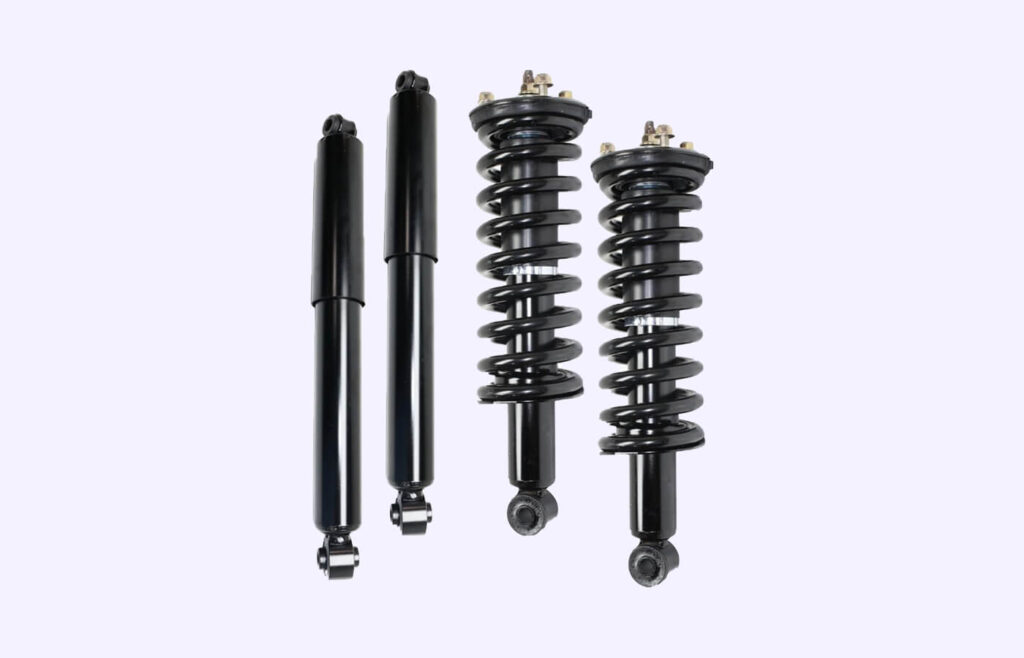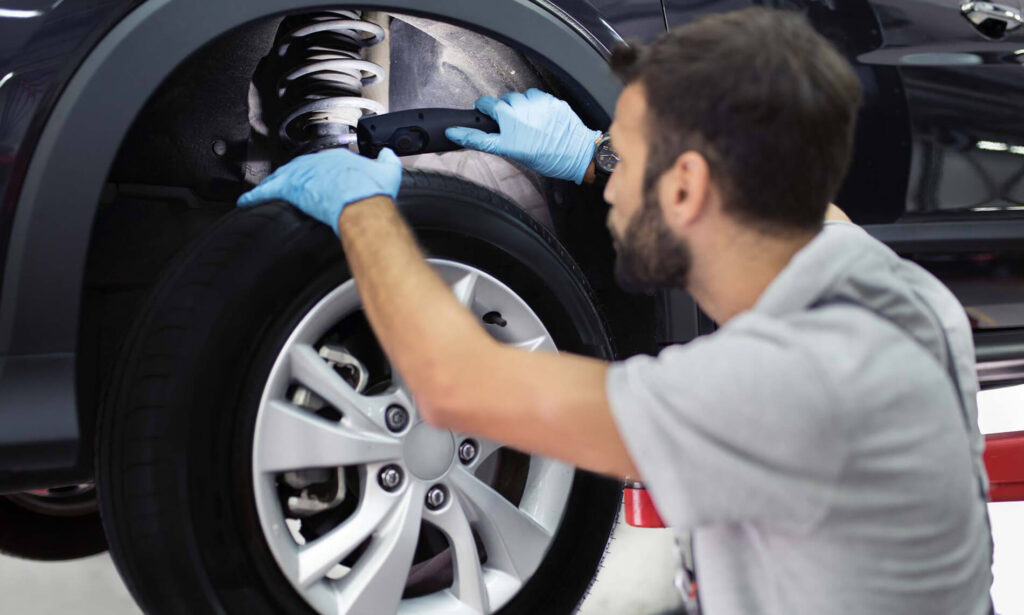Hitting the Road on a Bumpy Topic
Imagine cruising down the highway when suddenly you’re jolted by every bump and pothole. Your ride feels more like a wooden roller coaster than a modern vehicle. This less-than-smooth experience could be due to failing shock absorbers and struts, integral parts of your car’s suspension system that can’t be ignored without compromising safety and comfort.
The Backbone of Your Ride: What Are Shocks and Struts?
Imagine your vehicle as a professional dancer. Shock absorbers and struts are akin to that dancer’s spine, providing the necessary support and control for every twist, leap, and pirouette. When it comes to these vital components, it’s crucial to understand that while they might seem similar, they’re as distinct as ballet is from tap dancing. Shock absorbers, or simply “shocks,” are designed to dampen the impact of road irregularities, keeping your car from bouncing like a trampoline every time you hit a bump. They are stand-alone units, doing their job without any additional structural responsibilities in the vehicle. In essence, they absorb the ‘shock’ of the road, helping you maintain control and comfort.
Struts, on the other hand, wear multiple hats. They perform a similar function to shocks by dampening road impact but are integrated into the suspension system, serving as a structural component. Unlike shocks, struts provide a mounting place for your vehicle’s coil springs, effectively acting as a pivot point for the steering mechanism. This multifaceted role makes them critical to your car’s alignment and steering. Generally, you’ll find struts at the front of your vehicle, and shock absorbers at the rear, though this can vary depending on the car model.
Both shocks and struts are vital for a smooth and safe ride. They keep your tires in contact with the road, optimizing your vehicle’s grip and ensuring that features like anti-lock brakes and stability control can do their jobs effectively. In simpler terms, they are the unsung heroes keeping your ride smooth, ensuring you can tackle any winding road or sharp turn with the grace of a seasoned dancer.

Causes of Collapse: What Leads to Shock and Strut Failures?
Shock and strut failures don’t just happen overnight; there’s usually a combination of factors at play that lead to their eventual wear and tear. One primary culprit is simply the age of these components. With the average lifespan falling between 80,000 to 100,000 km, shocks and struts are typically not a “one and done” investment. Just like you wouldn’t expect to keep the same pair of running shoes for a decade, you shouldn’t expect these critical car parts to last forever. Regular checks after hitting the 80,000 km mark are highly recommended, especially if you frequently drive on challenging terrains.
Another key contributing factor is external damage. Believe it or not, your car doesn’t have to go through an action-movie level car chase to suffer. Everyday challenges like potholes, speed bumps, and even road salt in colder climates can inflict damage. Just as you wouldn’t run a marathon with a sprained ankle, driving with compromised shocks or struts can have a long-term impact on the vehicle’s overall health. This makes the case for periodic inspections, particularly if you live in an area where road conditions aren’t ideal.
Signs of an Impending Storm: Recognizing Worn Out Shocks and Struts
Don’t overlook these red flags; they’re your vehicle’s way of crying out for help:
• Excessive Bouncing: The car seems to have developed a pogo stick personality, bouncing excessively on uneven roads or even small bumps. This could mean your shocks and struts are wearing out.
• Clunking or Knocking Noises: If your car has started to sound like a percussion instrument, particularly during bumps or turns, this is often a symptom of failing shocks or struts.
• Poor Steering Response: Your vehicle seems to have a mind of its own, reacting sluggishly to steering or drifting during winds. Lackluster steering response can be a red flag.
• Tire Wear Patterns: Uneven or ‘cupped’ tire wear patterns often emerge when your shocks or struts are not doing their job in keeping the tires evenly on the road.
• Vehicle Sways or Leans: If your car seems to sway or lean during turns, lane changes, or when the wind is blowing, your suspension components may be compromised.
• Nose Dives or Rear Squats: During braking or acceleration, you notice the front of your car diving down or the rear squatting. This is a sign your shocks and struts might need a checkup.
• Visible Damage or Leaks: During a routine visual inspection, you may notice fluid leaking from the shock or strut body. Leaks are a definitive sign of failure.
The Aftermath: Consequences of Ignoring Failed Shocks and Struts
Turning a blind eye to failing shocks and struts is akin to ignoring a toothache—sooner or later, the pain will intensify, and the problem will get worse. In the context of your vehicle, compromised shocks and struts severely affect the car’s stability. The vehicle becomes much harder to control, especially during sharp turns, which elevates the risk of accidents. Additionally, you’ll start to notice that your car’s brakes don’t function as efficiently as they should. An unstable vehicle that’s hard to control is a recipe for disaster, potentially putting you and your passengers at risk.
If that’s not concerning enough, let’s talk about the domino effect on other parts of your vehicle. Your tires, for instance, will wear out unevenly and much faster when your shocks and struts are not in good shape. This leads to additional expenses and could even result in a dangerous blowout while driving. Uneven tire wear also reduces the efficiency of your car, leading to more frequent fuel stops. In essence, ignoring failing shocks and struts could lead to a series of unfortunate events that affect both your wallet and your well-being.
Test Drive: How to Check the Health of Your Shocks and Struts
For the DIYers out there:
1. Park on Level Ground: Make sure your car is parked on a level surface to get accurate results.
2. Push Down Test: Walk around your vehicle and push down hard on each corner of the car.
3. Observe the Bounce: After pushing down, let go and count how many times the car bounces.
4. Interpreting Results: If the car bounces more than twice, this is usually a sign that your shocks and struts need to be examined by a professional.
5. Take it to the Road: Drive your car around the block. Pay attention to the steering response, noises, and how your car handles bumps.
6. Consult the Pros: Regardless of your observations, if your vehicle has hit the 80,000 km mark, consider getting a professional opinion.

The Nuts and Bolts: Repair Scenarios and Cost Breakdown
You’re not just replacing the shock absorbers or struts; often, other parts might also need replacement. The costs can vary anywhere from a few hundred to over a thousand dollars for a comprehensive repair job.
• Replacement of Shock Absorbers or Struts: Just the primary component could set you back between $200 to $500 per piece, not including labor costs.
• Additional Components: Sometimes, mounts, bushings, or bearings also need replacement. This can add another $50 to $150 to your total bill.
• Labor Costs: Mechanic labor varies, but it’s usually between $100 and $300 per hour, depending on the complexity of the job.
• Alignment: After replacing shocks or struts, a wheel alignment is often necessary, adding an additional $75 to $200.
• Total Cost: A full repair, including all associated costs, could range from a few hundred dollars to potentially over $1,000, depending on your vehicle and what exactly needs to be replaced.
• Quality Matters: Opting for low-quality components may save money upfront but can cost more in the long run as they may fail sooner.
Remember, these are ballpark figures; a personalized quote from a reliable mechanic will give you the most accurate cost breakdown.
Conclusion: The Road Ahead – Shock and Strut Maintenance for Longevity
Proactive maintenance of your shocks and struts not only ensures a smoother ride but also enhances the longevity of your vehicle. For those who’d rather leave the heavy lifting to the pros, mobile mechanic services like Uchanics in Canada can come right to your doorstep, making the maintenance of these crucial components as convenient as possible.
